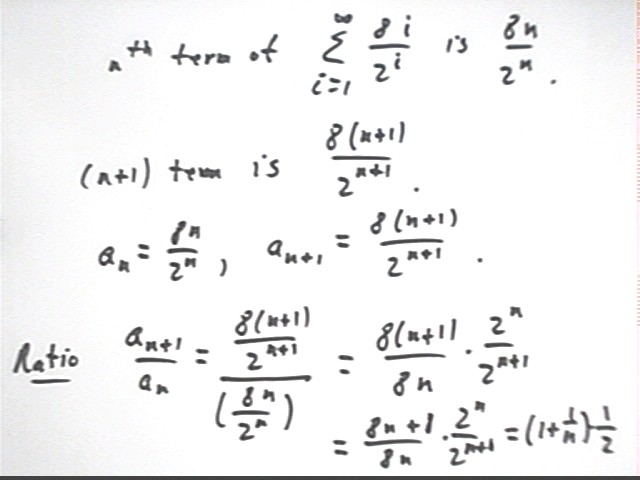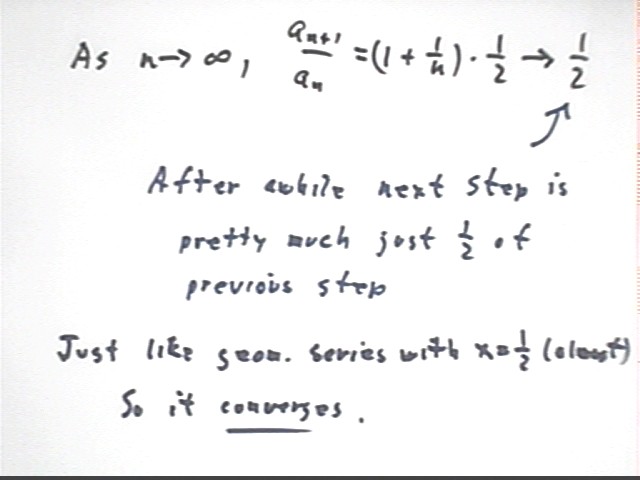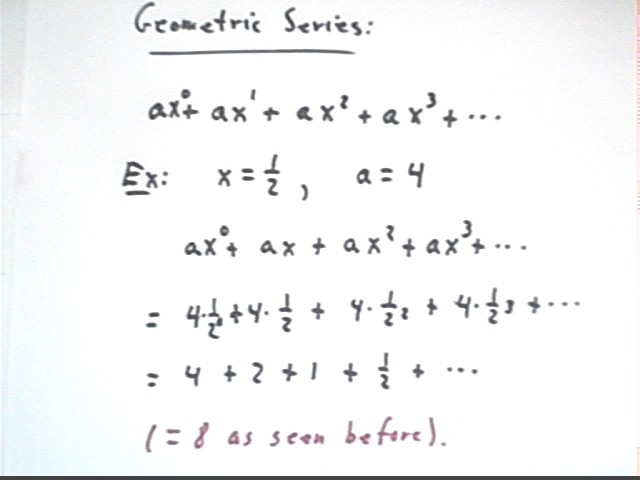
Calculus II Class 03/12
A geometric series has the form
This sum is written out in the figure below in the form a x^0 + a x^1 + a x^2 + ....

We note that 4 + 2 + 1 + 1/2 + ... can be written in two forms
and
The first form can be written sum(4 * 1/2^i, i from 0 to infinity) while the second can be written as sum(8 * 1/2^i, i from 1 to infinity), the only difference being that for the second seriesi starts at 1. Be sure you see that in both cases the starting value of i gives you 4 so that in both cases the series is 4 + 2 + 1 + 1/2 + ... .
It is also possible to write this series using 8 and allowing i to run from 0 to infinity. This form is sum(8 * 1 / 2^(i+1), i from 0 to infinity).
The graph in the figure below shows the rectangles whose total area represent the sum of the series, along with the function y = 8 / 2^x lying 'above' these rectangles and the function y = 8 / 2^(x+1) lying 'below'. We note that 8 / 2^(x+1) = 4 / 2^x; the connection between each of these functions and the corresponding way of expressing the sequence should be understood.
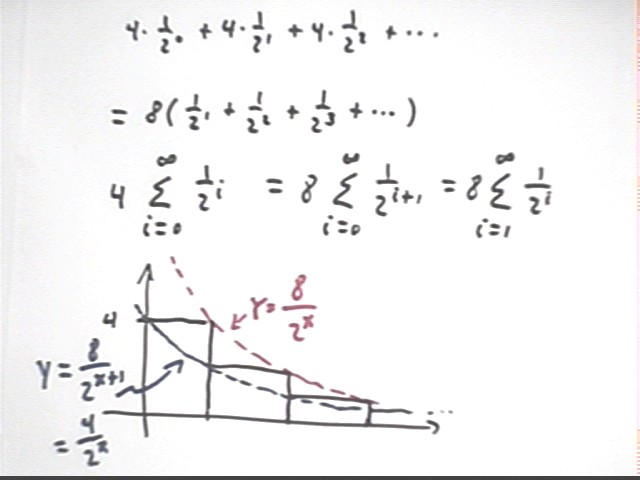
A typical series is expressed as a sum from i = 1 to infinity. The form given for a geometric series is often in the form of a sum from i = 0 to infinity. This can cause confusion if we don't know how to 'shift' the indices. Remember that:
The Nth partial sum S(N) of a series is the sum of its first N terms.
For the series 4 + 2 + 1 + 1/2 + ... defined by a(i) = 8 / (2^i), i from 1 to infinity, we get the following partial sums:
and
From what we have already seen about this series we know that as N gets larger and larger the partial sums behave as follows:
Our conclusion is that S(N) approaches 8 as a limit.
We express this by saying that
In general if the partial sums S(N) of a given series approach a limit as N -> infinity, the series is said to converge, whereas if S(N) does not approach a limit the series is said to diverge.
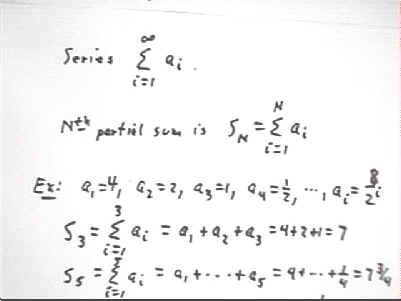
The series sum(a x^n, n from 0 to infinity) = a + a x + a x^2 + ... can be factored to give the form a ( 1 + x + x^2 + ... )
It can be proven that the partial sums S(N) = 1 + x + x^2 + ... + x^(N-1) of the series 1 + x + x^2 + x^3 + ... is
Since x^N approaches zero for large N whenever | x | < 1 and diverges when | x | > 1 it follows that (1 - x^N) / (1-x) converges for | x | < 1 and diverges for | x | > 1. Thus the sequence of partial sums S(N) converges for any x such that | x | < 1 to 1 / (1-x) and we say that
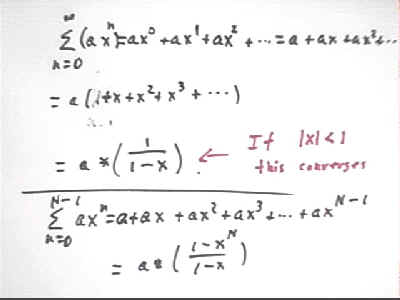
Applying this formula to the geometric series 4 + 2 + 1 + 1/2 + ... we conclude that the series converges to 8:
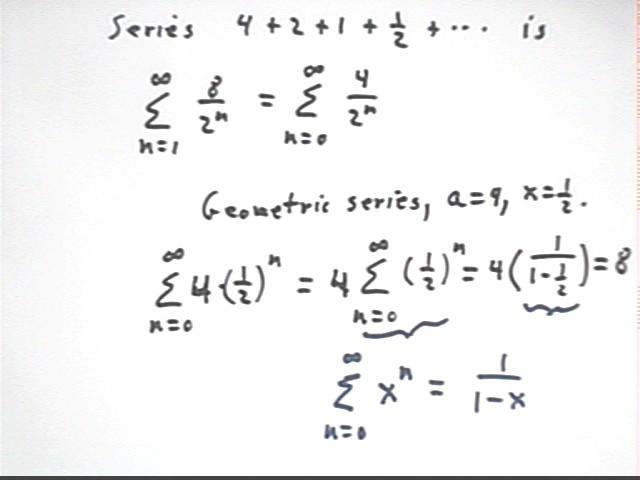
For the series 4 + 2 + 1 + 1/2 + ... the partial sums are 4, 6, 7, 7 1/2, 7 3/4, ... .
An upper bound of the partial sums is any number which greater than any of the partial sums.
For example, knowing that the partial sums S(N) of the above series 4 + 2 + 1 + 1/2 + ... never exceed 8 we can say that any number greater than 8 is an upper bound for the partial sums.
If a sequence of upper bounds has a finite upper bound then there are infinitely many upper bounds, since any number greater than the finite upper bound is also an upper bound.
We aren't really interested in how many upper bounds there are, and we aren't really interested in any of the upper bounds except one.
With this discussion in mind, imagine that a series has partial sums S1, S2, S3, ... with the property that each partial sum is greater than the one before it. Then the partial sums will look something like those indicated on the number line below.
Suppose that we know that there is some upper bound for this sequence. From what we've seen it follows that there are many upper bounds for the sequence. We observe the following:
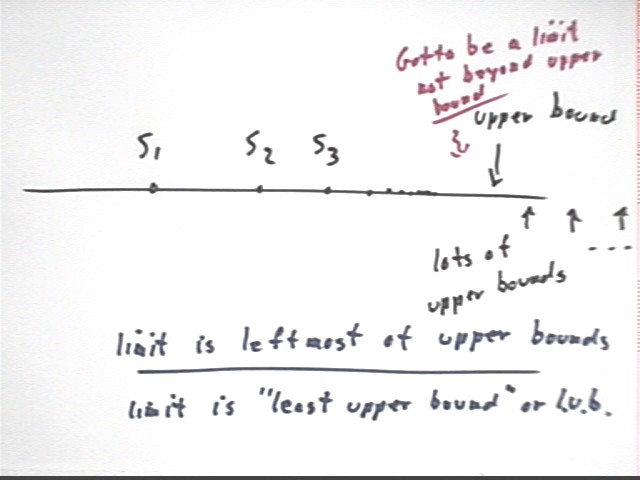
Recall that sum(8 / 2^i, i from 1 to infinity) converges to 8.
Since sum(36 / 3^i, i from 1 to infinity) can be written as 12 (1 + 1/3 + 1/3^2 + ... ) the series is geometric and must converge to 12 ( 1 / ( 1 - 1/3) ) = 18.
Another series is sum(8 / 2^i + 36 / 3^i, i from 1 to infinity). It seems very plausible that this series, being the sum of series converging to 8 and to 18, will converge to 8 + 18. It is not difficult to prove this by considering the partial sums of the 'new' series.
This is an instance of the theorem that tells us that if sum(a(i)) = a and sum(b(i)) = b, sum(a(i) + b(i) ) = a + b.
Other seemingly obvious properties of series can also be proved.
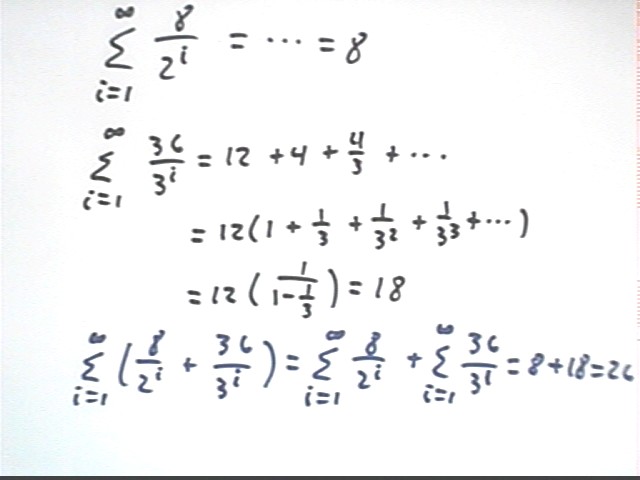
Now consider the question of whether sum(8 / ( i * 2*i), i from 1 to inifinity) converges:
Where does this get us? Well, we know from what by now should be vast experience that sum(8 / 2^i) converges (to 8). If the terms of another series are never greater than the terms of this series, then that series must also converge (and to a number not greater than 8).
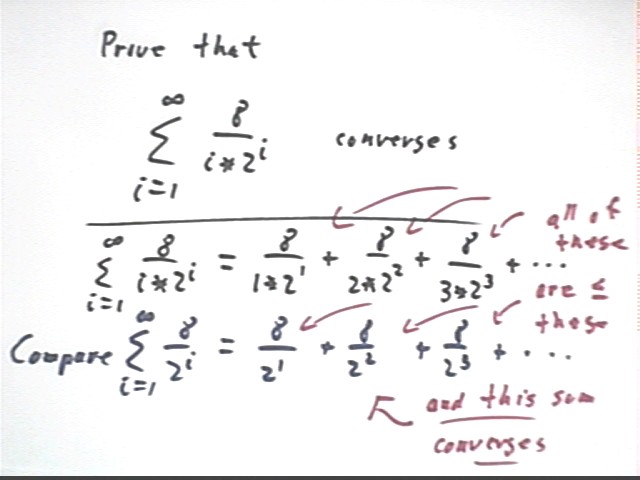
The figure below illustrates these two series as areas beneath two series of rectangles.
It follows that the 8 / (i * 2^i) series converges.
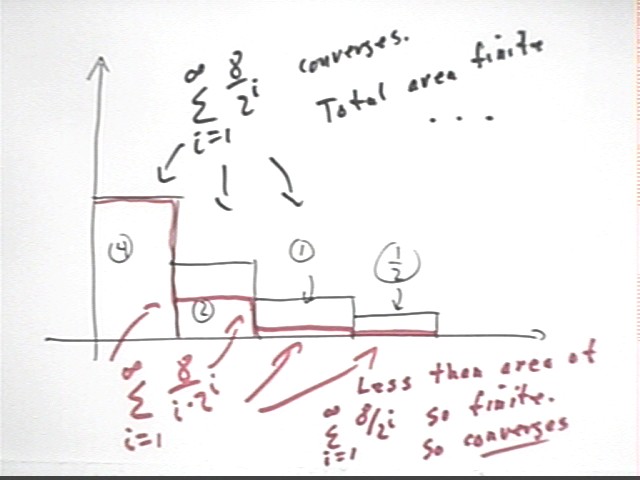
Now let's see if we can use similar reasoning on the series defined by 8 * i / 2^i. We compare this series with the known convergent series defined by 8 / 2^i.
This gives us the picture below, where the total area beneath the 8 * i / 2^i rectangles exceeds that beneath the 8 / 2^i rectangles.
We know that the total area under the 8 / 2^i rectangles is finite. What can we conclude about the total area under the 8 * i / 2^i rectangles?
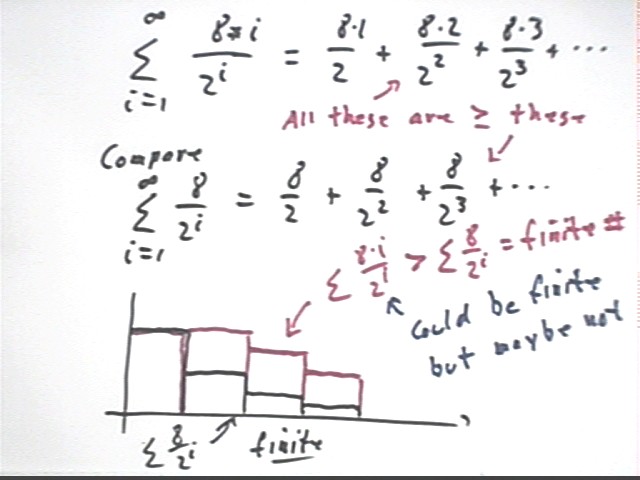
We can't prove it by making a comparison with the 8 / 2^i series but it turns out that the 8 * i / 2^i series does indeed converge. We reason as follows:
ratio = (a x^n) / (a x^(n-1)).
We conclude that any sequence where the absolute value of the ratio of each term to its predecessor stays less than 1 should behave like a geometric sequence in that it converges.
A rigorous proof that it is so can be accomplished and the proof follows this line of reasoning.
We apply this reasoning to the series defined by 8 i / 2^i:
ratio = a(n+1) / a(n) = [ 8 ( n + 1) / 2^(n+1) ] / [ 8 ( n ) / 2^(n) ].
ratio = (1 + 1/n) / 2.
As n approaches infinity, 1/n approaches zero and the ratio approaches
Since the ratio approaches 1/2 the series must eventually behave much like a geometric series with ratio 1/2. The result must be a series with a finite sum because:
In fact the argument just given isn't quite right. We can't really say that the series must eventually behave much like a geometric series with ratio 1/2. But we can say that for any number x greater than 1/2 (say, x = .50001) the series must converge faster than a geometric series with common ratio x. The argument is easily adapted.
